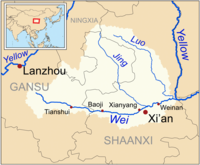
Back نهر وى (نهر) ARZ Вэйхэ Byelorussian Уейхъ (приток на Хуанхъ) Bulgarian Riu Wei Catalan Wei He (suba sa Pangmasang Republika sa Tśina, lat 34,61, long 110,28) CEB Wej-che (přítok Žluté řeky) Czech Вэйхэ CV Wei He Danish Wei He German Vei Esperanto

The Wei River (Chinese: 渭河; pinyin: Wèi Hé; Wade–Giles: Wei Ho) is a major river in west-central China's Gansu and Shaanxi provinces. It is the largest tributary of the Yellow River and very important in the early development of Chinese civilization.[1] In ancient times, such as in the Records of the Grand Historian, the river was called Wei Shui (渭水; Wèishuǐ; 'Wei water').
The total length of the Wei River is 818 km (508 mi), covering a drainage area of 135,000 km2 (52,000 sq mi). Some of the major tributaries include the Luo River, Jing River, Niutou River, Feng River and the Chishui River. In a direct line, it travels due east for 700 km (430 mi) before draining into the Yellow River at Tongguan County near the tri-provincial boundary between Shaanxi, Shanxi and Henan provinces, with a series of major cities along its course including Tianshui, Baoji, Xianyang, Xi'an and Weinan.
- ^ "Wei-River Gansu". Wei-River-Gansu-and-Shaanxi-provinces-China.
© MMXXIII Rich X Search. We shall prevail. All rights reserved. Rich X Search